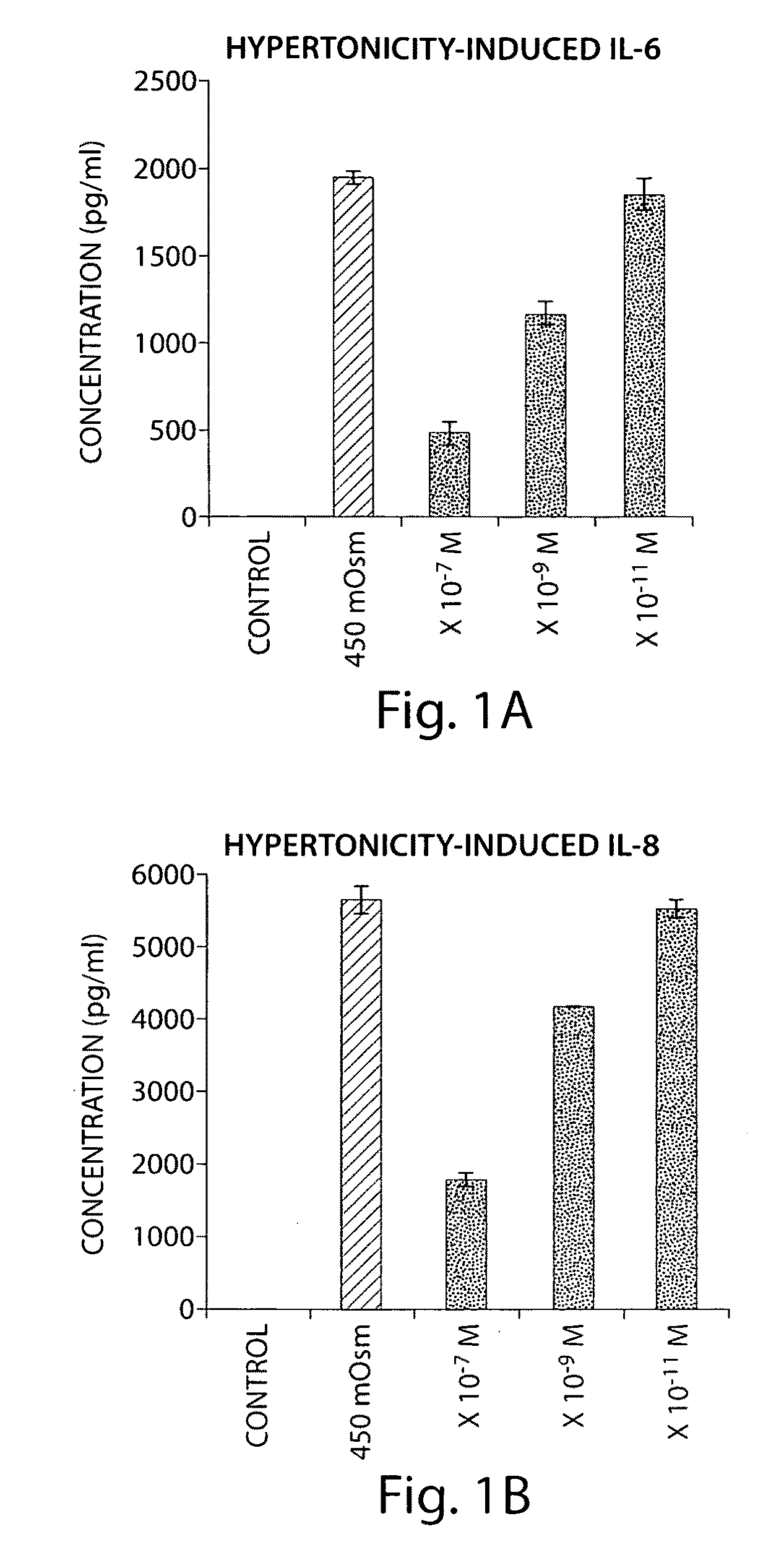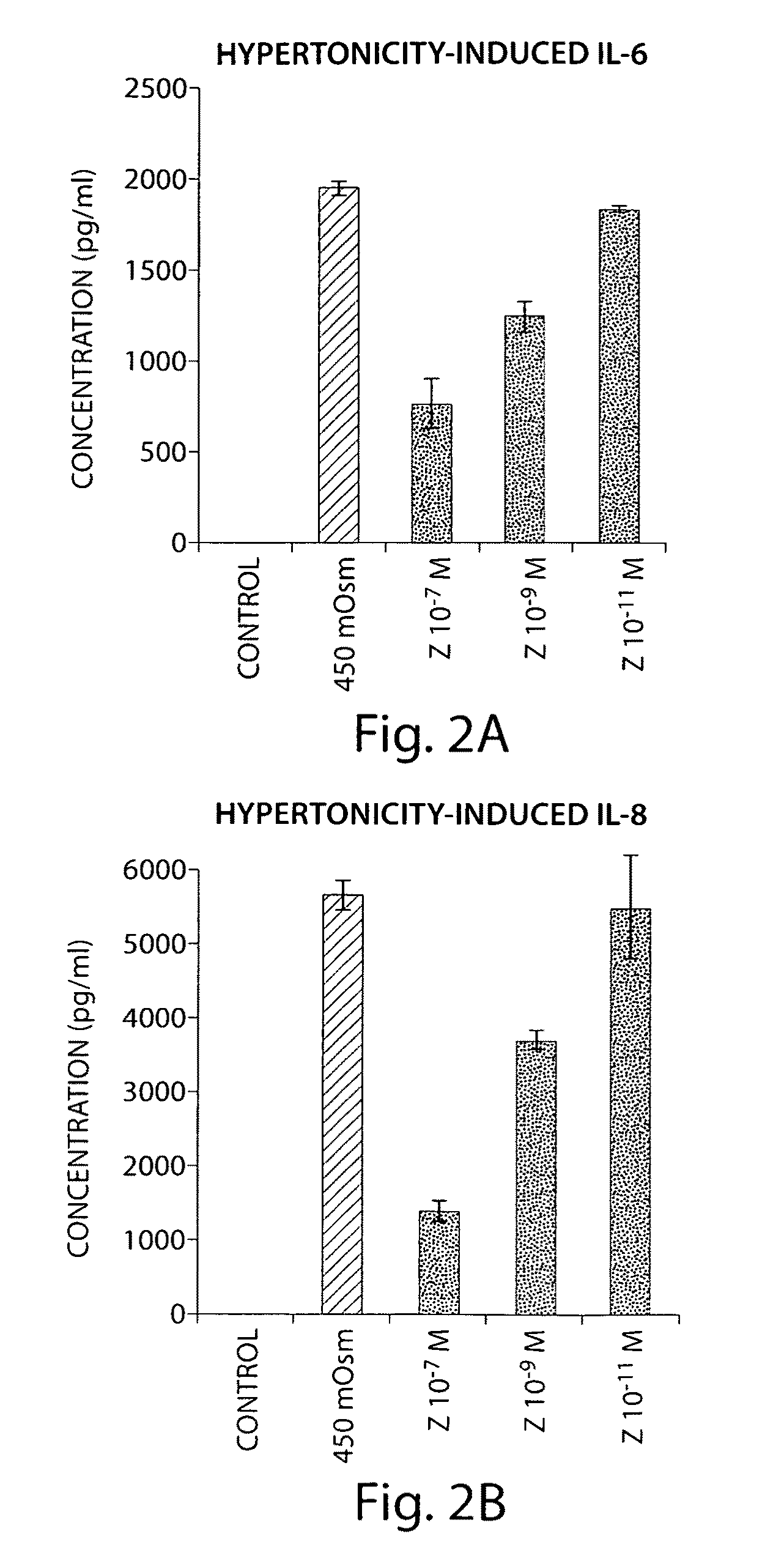Compositions and methods for the treatment of ophthalmic conditions
a technology for ophthalmic conditions and compositions, applied in the field of compositions and methods for the treatment of ophthalmic conditions, can solve the problems of inability to definitively stop the neural degeneration of glaucoma, the reversibility of glaucoma and the inability to cure or prevent diabetic retinopathy, and the increase of the number of amd cases is likely to be the same rate, so as to reduce the leakage of choroidal vascular, the leakage of choroidal
- Summary
- Abstract
- Description
- Claims
- Application Information
AI Technical Summary
Benefits of technology
Problems solved by technology
Method used
Image
Examples
example 1
Compounds X and Z Inhibit Hypertonicity-Induced Proinflammatory Cytokine Release in Human Corneal Epithelial Cells
[0498]Dry eye is commonly associated with tear film hypertonicity which may induce ocular surface inflammation and erosion. Accordingly, it is clinically relevant to identify novel approaches to suppress these stress responses. Compounds of formula A, compounds of any one of formulae 1-49, lipoxin compounds, oxylipin compounds, and the combination of aspirin and an omega-3 fatty acid, are highly potent and efficacious immune response regulators as shown in models of acute and chronic inflammation. Human corneal epithelial cells (HCEC) were used to investigate if compounds X,
and its analog compound Z,
could suppress a hypertonicity-induced increase in proinflammatory cytokine release.
Methods:
[0499]SV-40 immortalized HCEC were maintained in DMEM / F12 medium supplemented with 10% FBS and 5 ng / ml epidermal growth factor (EGF). The extracellular medium tonicity was varied from ...
example 2
Compounds V and W Protect Against Goblet Cell Loss and Reduce Corneal Epithelial Barrier Disruption in a Murine Model of KCS
[0502]The purpose of this study was to evaluate the potential of compound V,
and compound W,
in reducing inflammation and signs of disease in a murine model of dry eye.
Methods:
[0503]Experimental dry eye was created in C57BL / 6 mice by subcutaneous scopolamine injection and exposure to an air draft for 5 days, with or without topical therapy, 300 μg / mL of compound W, 300 μg / mL of compound V and polysorbate vehicle control, delivered 4 times per day as 1 μL drops. Untreated mice were used as controls. Corneal permeability was assessed using Oregon Green Dextran (OGD) staining. Goblet cell density was evaluated by PAS staining.
Results:
[0504]FIGS. 3 and 4, respectively, show that desiccating stress caused a significant goblet cell loss (4.97±0.88 vs. 6.18±0.86 cells / 100 μm, P<0.05, respectively) and a marked increase in corneal epithelial permeability to OGD compared ...
example 3
Compounds V and W Block the Over-Expression of Arginase and COX-2 in a Mouse Dry Eye Model
[0506]Dry eye (DE) is a common ocular surface disease, particularly among women and elderly population, which can cause eye irritation and blurred vision. Several studies have shown that there is an inflammatory component in DE, although the pathogenesis is not thoroughly understood. Compounds V and W were investigated in a mouse DE model.
Methods:
[0507]13 to 14-week-old female BALB / C mice were exposed to desiccating conditions, and 5 μl of 1% atropine was applied topically every other day. One week after DE exposure, the animals were treated with 5 μl of 0.01% compound V (100 μg / mL), 0.01% compound W (100 μg / mL) or vehicle topically 4 times per day for an additional week. Normal controls (NC) were animals in a normal environment without treatment. Corneas were processed for western blot analysis and immunofluorescence examination.
Results:
[0508]FIG. 5 shows results obtained by western blot analy...
PUM
| Property | Measurement | Unit |
|---|---|---|
| Composition | aaaaa | aaaaa |
Abstract
Description
Claims
Application Information
 Login to View More
Login to View More - R&D
- Intellectual Property
- Life Sciences
- Materials
- Tech Scout
- Unparalleled Data Quality
- Higher Quality Content
- 60% Fewer Hallucinations
Browse by: Latest US Patents, China's latest patents, Technical Efficacy Thesaurus, Application Domain, Technology Topic, Popular Technical Reports.
© 2025 PatSnap. All rights reserved.Legal|Privacy policy|Modern Slavery Act Transparency Statement|Sitemap|About US| Contact US: help@patsnap.com



